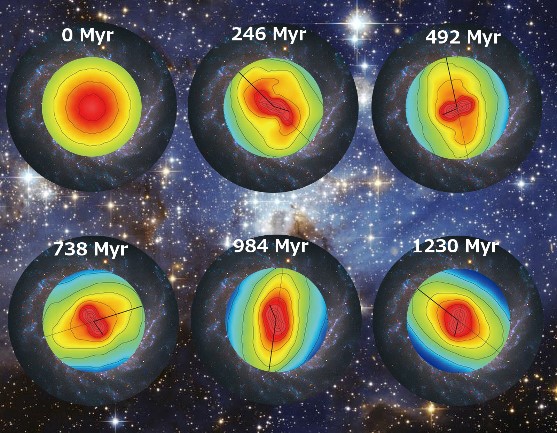How do barred galaxies get two bars?

Figure: The time evolution of the simulated S2B simulation at various times. Colors from red to blue refer to decreasing density. Short and Long straight line mark the secondary and primary bar respectively. Background image credit: NASA, ESA, STScI/AURA. Individual galaxy background image credit: ESO
Our method has not considered the direct effect from gas, showing that the secondary bar can be formed from pure disk instabilities,” said Du Min. “Such simple and natural forming conditions imply that small-scale secondary bar should be lurking in barred galaxies, even though we have not observed such “tiny” structures at high redshift because of the smaller sizes.”
How would these “tiny” structures grow? Prof. Shen explained, “There are several possibilities. Some may grow longer and larger by accreting matter and finally being transformed from S2Bs to commonly observed single bar spiral galaxies. It is possible that through interactions, the secondary bar would be captured by the primary bar and finally coupled together. In all, only a few S2Bs are stable until now.”
It is generally thought that gas is driven from outside in (a possible channel is provided by the primary bar), accumulation of gas giving rise to a cool disk that may be able to form a nuclear bar.
Prof. Debattista said, “with this work we have now demonstrated another method for forming double-barred galaxies without needing to resort to gas. The S2B phenomenon therefore is a phenomenon that requires the stars in the inner galaxy to be rotating differently from those further out.”
“In our alternative formation scenario, the secondary bar may form from the violent clumpy phase in the early universe when the primary bar is still not formed.” Prof. Shen concluded, “in many numerical simulations, these clumpy-origin small-scale bars could be easily mistaken as bulges. Therefore, the question remains whether the small-scale bar instabilities happens at the early time of the galaxy formation or after the formation of the primary bar. To better understand the formation of S2Bs, further simulations are required.”
Link to the research paper:
http://iopscience.iop.org/0004-637X/804/2/139/
News contact: Wenwen Zuo, wenwenzuo@shao.ac.cn, 34775125
Science contact: Juntai Shen, jshen@shao.ac.cn
Download attachments: